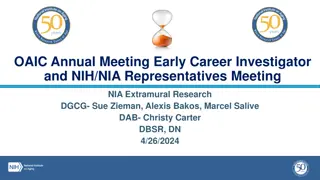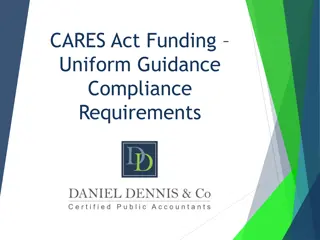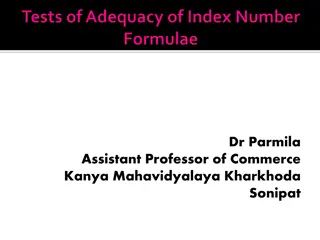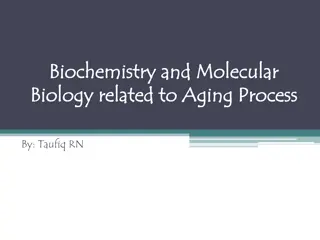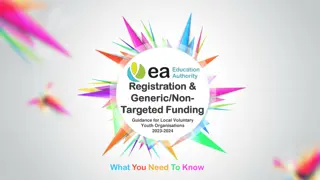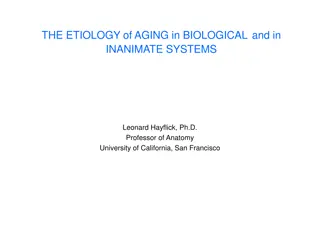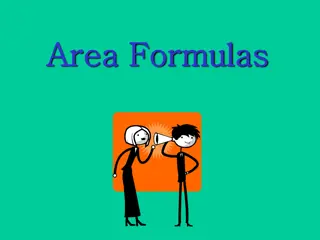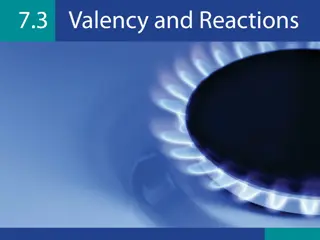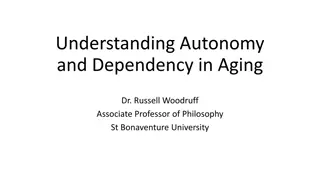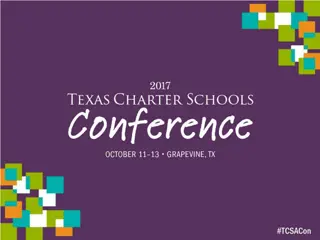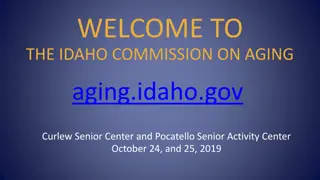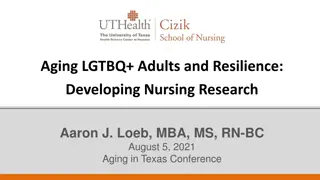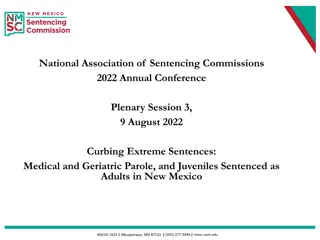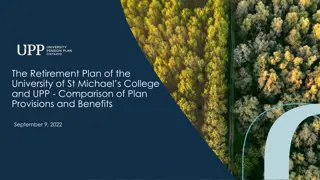State and Area Plans on Aging: Funding Formulas and Compliance Dates
Topics related to State and Area Plans on Aging, funding formulas, compliance dates, and OAA Final Rule provisions discussed in a webinar led by industry experts. Gain insights into important aspects of aging programs and regulations.
Download Presentation

Please find below an Image/Link to download the presentation.
The content on the website is provided AS IS for your information and personal use only. It may not be sold, licensed, or shared on other websites without obtaining consent from the author.If you encounter any issues during the download, it is possible that the publisher has removed the file from their server.
You are allowed to download the files provided on this website for personal or commercial use, subject to the condition that they are used lawfully. All files are the property of their respective owners.
The content on the website is provided AS IS for your information and personal use only. It may not be sold, licensed, or shared on other websites without obtaining consent from the author.
E N D
Presentation Transcript
1 Back to Basics: State and Area Plans on Aging, Intrastate Funding Formulas, and Interstate Funding Formulas Kari Benson, Deputy Assistant Secretary for Aging, ACL Adam Mosey, Special Assistant, Administration on Aging Cynthia Brammeier, Regional Administrator, Region VII Alice Kelsey, Deputy Director, Administration on Aging June 27, 2024
2 Housekeeping This webinar is being recorded The recording and slides from today's webinar will be posted in the coming weeks at https://acl.gov/OAArule All attendees are in listen only mode & chat feature is disabled. Place all questions in the Question & Answer (Q&A) box Questions will be answered live, time permitted American Sign Language (ASL) and Communication Access Realtime Translation (CART) services are provided. If needed, please click the appropriate option along the bottom of your Zoom screen.
3 Welcome Kari Benson, Deputy Assistant Secretary for Aging, ACL
4 Agenda Background Older Americans Act (OAA) Final Rule Provisions Review of Related OAA Sections Summary and Resources Please note: When a hyperlink is provided on a slide, the notes section will include the full website link.
5 Background
6 Back to Basics: What does it mean? Why now? What Meeting the mission and vision of the OAA by holistic program management: Program, fiscal, data, evaluation, training, communications, policies & procedures, all in alignment; Maintaining integrity of advocacy activities; and Targeted, effective, efficient activity Why Coincides with the first comprehensive update to OAA program regulations in 36 years Emerging from the COVID-19 pandemic Recent spate of retirements New and developing business opportunities Increased interest in stewardship of public funds
7 OAA Final Rule Provisions
8 Compliance Date Compliance Date: October 1, 2025. As the final rule goes into effect, we look forward to providing technical assistance and engaging with stakeholders regarding implementation of the final rule. For State Units on Aging (SUAs) that are unable to meet the October 1, 2025, compliance date, ACL will have a supportive corrective action plan process in place.
9 Layout of the Final Rule: Preamble (Sections I-III) & Regulatory Text We strongly encourage you to read the entire final rule. There are two basic sections: The first portion is the preamble: Background , explanation of the regulatory text, analysis and responses to public comments , required regulatory analyses The second portion is the final regulatory text in full for 45 CFR parts 1321 (Title III), 1322 (Title VI), and 1324 (Title VII) Note: shall = required, may = optional On March 15, 2024, the regulation was published in the Code of Federal Regulations (CFR), and can be found on www.ecfr.gov For a more detailed orientation to the final rule (e.g., webinars, additional resources), please visit ACL's OAA Regulations webpage: https://acl.gov/OAArule
10 General Note on the OAA Final Rule The vast majority of what is included in the final rule are long-established OAA requirements i.e., reaffirming what is in statute, prior regulations, or existing policies rather than new requirements.
11 Definitions Important definitions included in 1321.3 of the final rule for staff to be aware of include: Access services Area agency on aging Area plan administration Best available data Conflicts of interest Direct services Greatest economic need Greatest social need In-home supportive services Local sources Major disaster declaration Multipurpose senior center Periodic Planning and service area Program development and coordination activities Service provider Single planning and service area State State State agency State plan administration
12 Greatest Economic Need Greatest economic need (GEN), as used in the final rule, means the need resulting from an income level at or below the federal poverty level and as further defined by state and area plans based on local and individual factors, including geography and expenses.
13 Greatest Social Need Greatest social need (GSN), as used in the final rule, means the need caused by noneconomic factors, which include: (1) Physical and mental disabilities; (2) Language barriers; (3) Cultural, social, or geographical isolation, including due to: (i) Racial or ethnic status; (ii) Native American identity; (iii) Religious affiliation; (iv) Sexual orientation, gender identity, or sex characteristics; (v) HIV status; (vi) Chronic conditions; (vii) Housing instability, food insecurity, lack of access to reliable and clean water supply, lack of transportation, or utility assistance needs; (viii) Interpersonal safety concerns; (ix) Rural location; or (x) Any other status that: (A) Restricts the ability of an individual to perform normal or routine daily tasks; or (B) Threatens the capacity of the individual to live independently; or (4) Other needs as further defined by state and area plans based on local and individual factors.
14 1321.7 Organization and staffing of the State agency. The state shall designate a sole state agency (SUA) to develop and administer the state plan required under part 1321 and part 1324 and to serve as the effective and visible advocate for older adults within the state. This provision reflects the SUAs organization and staffing obligations with respect to part 1321 and part 1324, including regarding administration of the Ombudsman program and staffing for state legal assistance development.
15 State and Area Agency Policies and Procedures SUA policies and procedures must be developed in consultation with area agencies on aging (AAAs), program participants, and other appropriate parties in the state ( 1321.9). AAAs are required to develop policies and procedures in compliance with SUA policies and procedures, including those under 1321.9, in consultation with other appropriate parties in the planning and service area (PSA) ( 1321.59).
16 State and Area Plan-Related Fiscal Requirements 1321.9(c)(2)(i) Intrastate Funding Formula (IFF) 1321.9(c)(2)(ii) Non-Federal share (match) 1321.9(c)(2)(iv) State, Territory, and area plan administration. 1321.9(c)(2)(v) Minimum Adequate Proportion 1321.9(c)(2)(vi) Maintenance of Effort 1321.9(c)(2)(viii) Rural Minimum Expenditures 1321.9(c)(2)(xvii) Monitoring of State Plan Assurances
17 Designation of Planning and Service Areas and Area Agencies on Aging Provision State Plan Specific Note 1321.13 Designation of and designation changes to planning and service areas A state plan on aging or state plan on aging amendment must provide an explanation of consideration of listed factors when making changes. The SUAs that have responsibility for administering the programs within the interstate area must review and confirm a written agreement as part of their state plans on aging. SUAs must submit a state plan on aging or state plan on aging amendment when making changes. 1321.15 Interstate planning and service area 1321.19 Designation of and designation changes to area agencies
18 State Plan on Aging As part of their responsibilities, SUAs must develop and administer a multi- year state plan on aging and follow the guidance issued by the Assistant Secretary for Aging (ASA) regarding content, duration and formatting of the state plan: Unless otherwise indicated, an SUA may determine the format, how to collect information for the plan, and whether the plan will remain in effect for two, three, or four years. ( 1321.25 Duration, format, and effective date of the State plan.) The state plan delineates goals and objectives related to assisting older individuals and family caregivers and serves as a blueprint for achieving the goals and objectives during the plan period ( 1321.27 Content of State plan.).
19 1321.27 Content of State plan. Includes additional required core elements for the state plan, including that the state plan: Must provide evidence that it is informed by, and based on, area plans in states with multiple PSAs; Explain how individuals with greatest economic need and greatest social need are determined and served; Include the SUA s IFF or funds distribution plan; Identification of the geographic boundaries of each PSA and of AAAs designated for each PSA, if applicable; Demonstrate outreach to older Native Americans and coordination with tribes, Native communities and organizations, and Title VI programs under the Act;
20 1321.27 Content of State plan, Cont. Certify that program development and coordination activities will meet requirements; Specify the minimum proportion of funds that will be expended on certain categories of services (in-home supportive services, access services, legal assistance); Provide information if the SUA allows for Title III, part C-1 funds to be used as set forth in 1321.87(a)(1)(i); Describe how the SUA will meet its responsibilities for the Legal Assistance Developer ( 1324.303); Explain how the SUA will use its elder abuse prevention funding awarded pursuant to Title VII of the Act ( 1324.201); and Describe how the SUA will conduct monitoring of the assurances to which they attest.
21 1321.29 Public participation. The SUA is required to: Obtain the views of older individuals, family caregivers, service providers, and the public on a periodic basis, with a focus on those in GEN and GSN; Consider those views in developing and administering the state plan and policies and procedures regarding services provided under the plan; Establish and comply with a reasonable minimum time period (at least 30 calendar days) for public review and comment on new state plans and state plan amendments requiring approval of the ASA. SUAs may request a waiver of the minimum time period from the ASA during an emergency or when a time sensitive action is otherwise necessary; Ensure the documents noted in this section and final state plans and amendments are available to the public for review, as well as available in alternative formats and other languages if requested.
22 1321.31 Amendments to the State plan. Clarifies which amendments require prior approval by the ASA and which only need to be submitted for purposes of notification. Amendments requiring prior approval Amendments for purposes of notification only (within 30 days of the action) Those necessary to reflect a change in a state law, organization, policy, or SUA operation A change in the name or organizational placement of the SUA Distribution of state plan administration funds for demonstration projects A change in a PSA designation Those necessary to reflect new or revised statutes or regulations as determined by the ASA An addition, deletion, or change to an SUA s goal, assurance, or information requirement statement A change in the SUA s IFF or funds distribution plan for Title III funds A request to waive state plan requirements Other required changes A change in AAA designation Exercising of major disaster declaration (MDD) flexibilities, as set forth in 1321.101
23 1321.33 Submission of the State plan or plan amendment to the Assistant Secretary for Aging for approval. ACL s Regional Offices play a critical role in ACL s administration and oversight of state plans on aging. They provide technical assistance to SUAs regarding the preparation of state plans and amendments and are responsible for reviewing those that are submitted for compliance with the Act. The SUA must submit a draft of the plan or amendment to its assigned ACL Regional Office at least 120 calendar days prior to the proposed effective date, and cooperate with the Regional Office in the review of the plan or amendment for compliance with applicable requirements. The plan must be submitted to ACL for approval at least 90 calendar days before the proposed effective date of the plan or plan amendment. SUAs may request waiver(s) of the due dates in the event of exceptional circumstances.
24 State Plan / Amendment Notification 1321.35 Notification of State plan or State plan amendment approval or disapproval for changes requiring Assistant Secretary for Aging approval. The ASA shall approve a state plan or state plan amendment by notifying the Governor or the Governor's designee in writing. When the ASA proposes to disapprove a state plan or amendment, the ASA shall notify the Governor in writing, giving the reasons for the proposed disapproval, and inform the SUA that it may request a hearing on the proposed disapproval following the procedures described in guidance issued by the ASA. 1321.37: Notification of State plan amendment receipt for changes not requiring Assistant Secretary for Aging approval. The SUA shall submit an amendment not requiring ASA approval to the appropriate ACL Regional Office. The ACL Regional Office shall review the amendment to confirm the contents do not require approval of the ASA and will acknowledge receipt of the state plan amendment by notifying the head of the SUA in writing.
25 State Plan Appeals 1321.39 Appeals to the Departmental Appeals Board regarding State plan on aging. 1321.41 When a disapproval decision is effective. 1321.43 How the State agency may appeal the Departmental Appeals Board s decision.
26 1321.49 Intrastate funding formula (IFF) In states with multiple PSAs, SUAs provide funding to AAAs through the IFF. The SUA must include the IFF in the state plan, in accordance with guidelines issued by the ASA and using the best available data. The formula applies to supportive, nutrition, evidence-based disease prevention and health promotion, and family caregiver services provided under Title III of the Act. A separate formula for evidence- based disease prevention and health promotion may be used. SUAs must provide 30 calendar days or greater for public review and comment on IFF changes.
27 Intrastate Funding Formulas, Cont. 1 Elements of an IFF: A descriptive statement and application of the SUA s definitions of GEN and GSN; A statement that discloses any funds deducted for state plan administration, the Ombudsman program, or disaster set aside funds, as set forth in 1321.99; Whether there is a separate formula for evidence-based disease prevention and health promotion; How the Nutrition Services Incentive Program (NSIP) funds will be distributed; A numerical mathematical statement that describes each factor and the weight used for each factor; A listing of the population, economic, and social data to be used for each PSA in the state; A statement of the allocation of funds to each PSA in the state by part of Title III; and The source of the best available data used to allocate the funding.
28 Intrastate Funding Formulas, Cont. 2 Prohibitions include that the SUA may not: Withhold funds from distribution through the formula, except where expressly allowed for state plan administration, disaster set aside funds as set forth at 1321.99, or the Ombudsman program; Exceed state plan and area plan administration caps as detailed at 1321.9(c)(2)(iv); Use Title III, part D funds for area plan administration; Distribute funds to any entity other than a designated AAA, except where expressly allowed for state plan administration funds, Title III, part B Ombudsman program funds, and disaster set-aside funds as set forth in 1321.99; and Use funds in a manner that is in conflict with the Act.
29 1321.51 Single planning and service area States: Funds Distribution Plans As part of their state plan submission, single PSA states must provide a funds distribution plan which includes: A descriptive statement as to how the SUA determines the geographical distribution of the Title III and NSIP funding; How the SUA targets the funding to reach individuals with GEN and GSN, with particular attention to low-income minority older individuals; At the option of the SUA, a numerical/mathematical statement as a part of their funds distribution plan; and Justification if the SUA determines it meets requirements to provide services directly.
30 1321.51 Single planning and service area States: Funds Distribution Plans, Cont. If a single PSA state revises their Title III funds distribution plan, they may do so by: Following their policies and procedures to publish the updated funds distribution plan for public review and comment for a reasonable minimum time period (30 calendar days or greater, unless a waiver is provided by the ASA during an emergency or when a time sensitive action is otherwise necessary); and Submitting the revised funds distribution plan for ASA approval prior to implementing the changes as noted at 1321.33.
31 1321.63 Area agency advisory council. The council shall advise the agency relative to: Developing and administering the area plan; Ensuring the plan is available to older individuals, family caregivers, service providers, and the general public; Conducting public hearings; Representing the interests of older individuals and family caregivers; and Reviewing and commenting on community policies, programs and actions which affect older individuals and family caregivers. The AAA shall submit the area plan and amendments for review and comment to the advisory council before it is transmitted to the SUA for approval.
32 1321.65 Submission of an area plan and plan amendments to the State agency for approval. The AAA shall submit the area plan on aging and amendments specific to each PSA to the SUA for approval following procedures specified by the SUA in the SUA policies prescribed by 1321.9. SUA policies and procedures regarding area plan requirements will at a minimum address the following: Content, duration, and format; That the AAA shall identify populations within the PSA at GEN and GSN, which shall include the populations as set forth in the 1321.3 definitions; Assessment and evaluation of unmet need for supportive services, nutrition services, evidence- based disease prevention and health promotion services, family caregiver support services, and multipurpose senior centers; and Public participation specifying mechanisms to obtain the periodic views of older individuals, family caregivers, service providers, and the public with a focus on those in GEN & GSN.
33 1321.65 Submission of an area plan and plan amendments to the State agency for approval, Cont. 1 A definition of each service; number of individuals to be served; type and number of units; and corresponding expenditures proposed with funds under the Act and related local public sources; Plans for how direct services funds under the Act will be distributed within the PSA, in order to address populations identified as in GSN and GEN, as identified in 1321.27(d)(1); Process for determining whether the AAA meets requirements to provide services directly; Minimum adequate proportion requirements, as identified in the approved state plan ( 1321.27); Requirements for program development & coordination activities ( 1321.27(h)), if allowed by the SUA; If the AAA requests to allow Title III, part C-1 funds to be used as set forth in 1321.87(a)(1)(i) through (iii) for shelf-stable, pick-up, carry-out, drive-through, or similar meals to complement the congregate meals program, it must provide the specified information to the SUA; Initial submission and amendments; Approval by the SUA; and Appeals regarding area plans on aging.
34 1321.65 Submission of an area plan and plan amendments to the State agency for approval, Cont. 2 Area plans shall incorporate services which address the incidence of hunger, food insecurity and malnutrition; social isolation; and physical and mental health conditions. Pursuant to section 306(a)(16) of the Act, area plans shall provide, to the extent feasible, for the furnishing of services under this Act, through self- direction. Area plans on aging shall develop objectives that coordinate with and reflect the state plan goals for services under the Act.
35 Title III/VI Coordination Coordination is required under the Act and all entities are responsible for coordination, including SUAs, AAAs, service providers, and Title VI grantees. See https://acl.gov/OAArule State plans must explain how a state s aging network, including AAAs & service providers, will coordinate with Title VI programs, including in emergencies and disasters. Title VI grantees are required to have processes for providing feedback on the state plan and any area plans on aging relevant to the Title VI grantee s approved service area. Under part 1321, see 1321.53 State agency Title III and Title VI coordination responsibilities, 1321.69 Area agency on aging Title III and Title VI coordination responsibilities, 1321.95 Service provider Title III and Title VI coordination responsibilities, and 1321.103 Title III and Title VI coordination for emergency and disaster preparedness. Under part 1322, see 1322.31 and 1322.37
36 Emergencies and Disasters 1321.99 Setting aside funds to address disasters: Clarifies that SUAs may specify that they are setting aside Title III funds for disaster relief in their IFF or funds distribution plan, and provides direction as to the process an SUA must follow in order to award such funds for use within all or part of a PSA covered by a specific MDD where Title III services are impacted, as well as requirements with respect to the awarding of such funds. 1321.101 Flexibilities under a major disaster declaration: (b) outlines flexibilities an SUA may exercise under an MDD. An SUA must submit a state plan amendment as set forth in 1321.31(b) if the SUA exercises any of these flexibilities. The state plan amendment must at a minimum include the specific entities receiving funds; the amount, source, and intended use for funds; and other such justification of the use of funds.
37 1324.15 State agency responsibilities related to the Ombudsman program. 1324.15(g) State and area plans on aging: The SUA shall integrate the goals and objectives of the Office of the State Long-Term Care Ombudsman (the Office) into the state plan and coordinate the goals and objectives of the Office with those of other programs established under Title VII of the Act and other state elder rights, disability rights, and elder justice programs, including, but not limited to, legal assistance programs provided under section 306(a)(2)(C) of the OAA, to promote collaborative efforts and diminish duplicative efforts. Where applicable, the SUA shall require inclusion of goals and objectives of local Ombudsman entities into area plans.
38 Review of Related OAA Sections
39 Interstate Funding Formula The Older Americans Act directs the distribution of awards through the interstate funding formula: Title III Parts B and C1: OAA Section 304(a) Title III Parts C2 and D: OAA Section 304(a) Title III Part E: OAA Section 373(g) NSIP: OAA Section 311(b) Title VII: Chapter 2 (Ombudsman) and Chapter 3 (Elder Abuse Prevention): OAA Section 703(a) Allocation tables by state on ACL website
40 Interstate Funding Formula: Data Title III Parts B, C1, C2, D, and Title VII: Latest Census Estimates of State s 60+ population Compilations of the Census data by population age 60+ Title III Part E: Latest Census Estimates of State s 70+ population Compilations of the Census data by population age 70+ NSIP: Number of NSIP Meals Reported on most recent State Program Report (Title III) and Tribal Program Report (Title VI)
41 Interstate Funding Formula: Title III B & C1 Title III B & C1: OAA Section 304(a) Data: Latest Census Estimates of State s 60+ population Compilations of the Census data by population age 60+ Formula (for B and C1 allocations): divide total appropriated funding from B and C1 into two parts: Part 1: Fiscal Year (FY) 2019 total amount appropriated; and Part 2: Remaining balance of current fiscal year appropriation that exceeds Part 1.
43 Interstate Funding Formula: Title III B & C1, Cont. 1 Part 1: Allocate Amount Equal To FY2019 Appropriation 1. Allocate to states/territories a proportional amount according to latest Census 60+ population percentages; 2. State/territory minimum amount ; Minimum is percent of allocation amount for all states/territories, except: percent for Guam and U.S. Virgin Islands 1/16 percent for American Samoa and Northern Mariana Islands 3. State/territory hold harmless amount which is reduced by percent (0.25%) from FY2019 levels through FY2029; For FY2020, no state/territory receives less than 99.75% of the annual allotment to it for FY2019; FY2021 - 99.50%; FY2022 - 99.25%; FY2023 - 99.00%; FY2024 - 98.75%; FY2025 - 98.50%; FY2026 - 98.25%; FY2027 - 98.00%; FY2028 - 97.75%; FY2029 97.50%; For FY2030, the provision eliminates the hold harmless provision. o o
44 Interstate Funding Formula: Title III B & C1, Cont. 2 Part 1: Allocate Amount Equal To FY2019 Appropriation (continued) 4. Larger of two amounts calculated in steps 2 and 3 becomes the state/territory minimum amount ; 5. By state/territory, compare step 1 to minimum amount (step 4 above) and adjust to minimum amount and adjust other states/territories that are above the minimum amount accordingly; 6. Repeat step 5 until all states/territories meet the minimum amount (step 4); 7. Apply interstate transfers (OAA 305(b)(3) and 1321.15 Interstate planning and service area).
45 Interstate Funding Formula: Title III B & C1, Cont. 3 Part 2: Allocate Amount that Exceeds Part 1 (FY 2019 Appropriation) 1. Allocate to states/territories a proportional amount according to latest Census 60+ population percentages; 2. State/territory minimum amount ; Minimum is percent of allocation amount for all states/territories, except: o percent for Guam and U.S. Virgin Islands o 1/16 percent for American Samoa and Northern Mariana Islands 3. By state/territory, compare step 1 to minimum amount (step 2 above) and adjust to minimum amount and adjust other states/territories that are above the minimum amount accordingly; 4. Repeat step 3 until all states/territories are at minimum; 5. Apply interstate transfers (OAA 305(b)(3) and 1321.15 Interstate planning and service area). Add Part 1 and Part 2 for total grant allocation for each state/territory.
46 Interstate Funding Formula: Title III C2 & D Title III C2 & D: OAA Section 304(a) Data: Latest Census Estimates of State s 60+ population Compilations of the Census data by population age 60+ Formula (for C2 and D allocations): 1. Allocate to states/territories a proportional amount according to Census 60+ population percentages; The formula does not include hold harmless amount 2. State/territory minimum amount ; Minimum is percent of allocation amount for all states/territories, except: percent for Guam and U.S. Virgin Islands 1/16 percent for American Samoa and Northern Mariana Islands o o
47 Interstate Funding Formula: Title III C2 & D, Cont. Formula (for C2 and D allocations) (continued): 3. By state/territory, compare step 1 to minimum amount (step 2 above) and adjust to minimum amount and adjust other above minimum states/territories that are above the minimum amount accordingly; 4. Repeat step 3 until all states/territories are at minimum; 5. Apply interstate transfers.
48 Interstate Funding Formula: Title III E Title III E: OAA Section 373(g) Data: Latest Census Estimates of State s 70+ population Compilations of the Census data by population age 70+ Formula: 1. Allocate to states/territories a proportional amount according to Census 70+ population percentages; 2. State/territory minimum amount ; Minimum is percent of allocation amount for all states/territories, except: o percent for Guam and U.S. Virgin Islands o 1/16 percent for American Samoa and Northern Mariana Islands 3. By state/territory, compare step 1 to minimum amount (step 2 above) and adjust to minimum amount and adjust other above minimum states/territories that are above the minimum amount accordingly; 4. Repeat step 3 until all states/territories are at minimum; 5. Apply interstate transfers.
49 Interstate Funding Formula: Nutrition Supplemental Incentive Program (NSIP) Title NSIP: OAA Section 311(b) Data: Number of NSIP Meals Reported on most recent State Program Report (Title III) and Tribal Program Report (Title VI) Formula: 1. Allocate to state/territories/tribes proportionally based on the total number of NSIP meals reported in the prior year. For states/territories/tribes that requested United States Department of Agriculture (USDA) commodities ACL reduces the NSIP cash allocation based on the value of the commodities elected and associated administrative fees
50 Interstate Funding Formula: Title VII Title VII Chapter 2 (Ombudsman) and Chapter 3 (Elder Abuse Prevention): OAA Section 703(a) Data: Latest Census Estimates of State s 60+ population Compilations of the Census data by population age 60+ Formula (for Chapter 2 and 3 allocations): 1. Allocate to states/territories a proportional amount according to Census 60+ population percentages; 2. State/territory minimum amount ; Minimum is percent of allocation amount for all states/territories, except: percent for Guam and U.S. Virgin Islands 1/16 percent for American Samoa and Northern Mariana Islands 3. State/territory hold harmless amount; FY2000 allotment amount; o o



